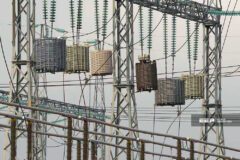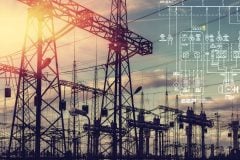
Description, Causes and Consequences
The most common types of Power Quality problems are presented below along with their description, causes and consequences:
- Voltage sag (or dip)
- Very short interruptions
- Long interruptions
- Voltage spike
- Voltage swell
- Harmonic distortion
- Voltage fluctuation
- Noise
- Voltage Unbalance
1. Voltage sag (or dip)

Description: A decrease of the normal voltage level between 10% and 90% of the nominal rms voltage at the power frequency, for durations of 0,5 cycle to 1 minute.
Causes: Faults on the transmission or distribution network (most of the times on parallel feeders). Faults in consumer’s installation. Connection of heavy loads and start-up of large motors.
Consequences: Malfunction of information technology equipment, namely microprocessor-based control systems (PCs, PLCs, ASDs, etc) that may lead to a process stoppage. Tripping of contactors and electromechanical relays. Disconnection and loss of efficiency in electric rotating machines.
2. Very short interruptions

Description: Total interruption of electrical supply for duration from few milliseconds to one or two seconds.
Causes: Mainly due to the opening and automatic reclosure of protection devices to decommission a faulty section of the network. The main fault causes are insulation failure, lightning and insulator flashover.
Consequences: Tripping of protection devices, loss of information and malfunction of data processing equipment. Stoppage of sensitive equipment, such as ASDs, PCs, PLCs, if they’re not prepared to deal with this situation.
3. Long interruptions

Description: Total interruption of electrical supply for duration greater than 1 to 2 seconds
Causes: Equipment failure in the power system network, storms and objects (trees, cars, etc) striking lines or poles, fire, human error, bad coordination or failure of protection devices.
Consequences: Stoppage of all equipment.
4. Voltage spike

Description: Very fast variation of the voltage value for durations from a several microseconds to few milliseconds. These variations may reach thousands of volts, even in low voltage.
Causes: Lightning, switching of lines or power factor correction capacitors, disconnection of heavy loads.
Consequences: Destruction of components (particularly electronic components) and of insulation materials, data processing errors or data loss, electromagnetic interference.
5. Voltage swell

Description: Momentary increase of the voltage, at the power frequency, outside the normal tolerances, with duration of more than one cycle and typically less than a few seconds.
Causes: Start/stop of heavy loads, badly dimensioned power sources, badly regulated transformers (mainly during off-peak hours).
Consequences: Data loss, flickering of lighting and screens, stoppage or damage of sensitive equipment, if the voltage values are too high.
6. Harmonic distortion

Description: Voltage or current waveforms assume non-sinusoidal shape. The waveform corresponds to the sum of different sine-waves with different magnitude and phase, having frequencies that are multiples of power-system frequency.
Causes: Classic sources: electric machines working above the knee of the magnetization curve (magnetic saturation), arc furnaces, welding machines, rectifiers, and DC brush motors.
Consequences: Increased probability in occurrence of resonance, neutral overload in 3-phase systems, overheating of all cables and equipment, loss of efficiency in electric machines, electromagnetic interference with communication systems, errors in measures when using average reading meters, nuisance tripping of thermal protections.
7. Voltage fluctuation

Description: Oscillation of voltage value, amplitude modulated by a signal with frequency of 0 to 30 Hz.
Causes: Arc furnaces, frequent start/stop of electric motors (for instance elevators), oscillating loads.
Consequences: Most consequences are common to undervoltages. The most perceptible consequence is the flickering of lighting and screens, giving the impression of unsteadiness of visual perception.
8. Noise

Description: Superimposing of high frequency signals on the waveform of the power-system frequency.
Causes: Electromagnetic interferences provoked by Hertzian waves such as microwaves, television diffusion, and radiation due to welding machines, arc furnaces, and electronic equipment. Improper grounding may also be a cause.
Consequences: Disturbances on sensitive electronic equipment, usually not destructive. May cause data loss and data processing errors.
9. Voltage Unbalance

Description: A voltage variation in a three-phase system in which the three voltage magnitudes or the phase-
angle differences between them are not equal.
Causes: Large single-phase loads (induction furnaces, traction loads), incorrect distribution of all single-phase loads by the three phases of the system (this may be also due to a fault).
Consequences: Unbalanced systems imply the existence of a negative sequence that is harmful to all three- phase loads. The most affected loads are three-phase induction machines.
Reference: Power Quality Problems and New Solutions – A. de Almeida, L. Moreira. J. Delgado (Download paper)











I have three phase electric connection in my house. Recently developed a problem. When I switch on gyser in one bathroom, or use heater or microwave oven, the voltage drops from 230 to 150. When I use these gadgets in another room the voltage rises from 230 to 280-290. Normal electricians are unable to resolve the issue. Please guide.
Hello Edvard, Thank you for your continuous informative and useful article.
In voltage sag the duration is 0.5 cycle to 1 cycle or 1 minute? Please confirm.
Because 1 minute is very long time for a voltage dip from 10 to 90%, right?
EXCELLENT ARTICLE
Well explained….Weldone!
Nice presentation. Really helpful
When industrial high load induction motors start on load, it caused heavy dips. It is necessary to see that capacitors should be connected with such loads.
Briefly and nicely explained.
I had no idea that TVs, welding machines, etc. could cause disturbances on sensitive equipment. What is the best way to avoid this other than not using these items around sensitive equipment? Could you put some kind of insulator on the equipment?
this is an excellent description list of the problems that poor power quality causes. But I cannot for the life of me understand why people don’t just eliminate them entirely with Nanocorrection.
These are all problems of the past now. They are fully corrected and no longer problems with the VectorQ2 system.
Pure power quality all the time is the standard we and many others live with. You should too and save yourself these
Headaches.
Thank you for such a nice article
Very useful
I need to use the app in offline,i think it is useful verymuch